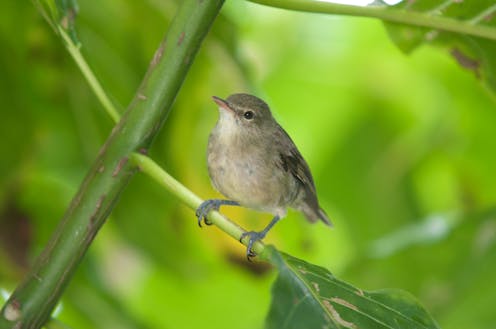extreme weather pushes couples past breaking point
- Written by Frigg Janne Daan Speelman, PhD Candidate in behavioural ecology, Macquarie University

Like humans, many animals form lasting monogamous relationships. Most birds pair up to produce and raise offspring together over many years. However, as with humans, they also commonly “divorce” – terminating the pair bond well before the death of either partner.
Our new research examines the link between extreme weather events and divorce in a small monogamous tropical songbird.
We found extreme events – at both ends of the spectrum, both wet and dry – increase divorce rates in these birds.
With climate patterns becoming increasingly erratic, it’s vital to understand how such extreme events affect the species we share our planet with. If it’s disturbing their love lives, this may have dire consequences for the ability of species to reproduce and survive.
Back from the brink of extinction
The Seychelles warbler is endemic to the Seychelles islands in the Indian Ocean.
Once on the brink of extinction, with just 26 birds left in the world, this species now has a stable population on Cousin Island. It’s a great conservation success story – to save the species, the entire island and surrounding sea was turned into a nature reserve in the late 1960s and early 1970s.
Seychelles warbler pairs can stay together for up to 15 years. But somewhere between 1% and 16% of partnerships break up every year.
Why? It’s thought divorcing may allow these birds to correct for a poor choice of partner. A poor match typically results in a failure to produce chicks and fledglings, which makes the birds reconsider their choice of partner and look elsewhere. But sometimes they divorce for no apparent reason.
Many factors could misinform these birds, causing them to separate when it is not in their best interests. Maybe even bad weather.
Using a unique dataset spanning decades, we determined the relationship status of all birds on the island over 16 years. We then related that to rainfall data from the local meteorological station.
Fair-weather friends
We found the probability of divorce was closely associated with the amount of rainfall experienced in the seven months leading up to and during the breeding season. Divorce rates spiked both when rainfall was extreme: either very wet or very dry.
A super El Niño event in 1997 caused exceptionally heavy rainfall that year: 1,430mm compared with the average 884mm. Many Seychelles warblers divorced that year (15.3%).
More couples also broke up in drought years.
It seems these birds tend to stick together when the weather is good, but separate when it turns bad.
How weather affects partnership stability
Divorce in many species is often directly linked to poor breeding success, when a couple fails to rear young in the prior breeding season. But in our study we found no evidence to suggest that’s an issue in Seychelles warblers.
While the period of rainfall that predicted divorce also influenced the ability of these birds to produce offspring, failing to become parents did not make Seychelles warbler pairs more likely to divorce. Some birds that divorced did produce offspring successfully, and some that didn’t produce offspring stayed together. This suggests other, more complex factors may be at play.
Extreme weather affects the physical environment, changing food availability, habitat and nesting conditions. Prolonged lack of rain before breeding begins can also affect the health of birds.
Maintaining the right body temperature during periods of extreme rainfall is challenging for many bird species. This may increase the level of stress birds experience and increase instability in their partnerships. But it may not necessarily result in a failure to breed altogether.
What we can learn from this
Our new research sheds light on another heartbreaking consequence of climate change: extreme events are destabilising partnerships in wild animals.
Birds such as the Seychelles warbler are particularly vulnerable to these changes because, like many other species, their reproductive strategies are closely linked to environmental conditions.
As we continue to face the challenges posed by climate change, studies such as this are essential. They offer vital information for conservationists working to protect species that are highly sensitive to their environment. This is especially important particularly for isolated populations that can’t move to adjust.
As extreme weather is becoming more common, we will likely see more dramatic shifts in the social structures of many species, affecting not only their survival but the entire ecosystems they inhabit.
Authors: Frigg Janne Daan Speelman, PhD Candidate in behavioural ecology, Macquarie University





